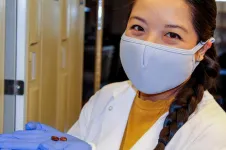(Press-News.org) About one billion people worldwide are at risk for schistosomiasis -- a debilitating disease caused by parasitic worms that live in fresh water and in intermediate snail hosts. A new study finds that the transmission risk for schistosomiasis peaks when water warms to 21.7 degrees centigrade, and that the most effective interventions should include snail removal measures implemented when the temperature is below that risk threshold.
The Proceedings of the National Academy of Sciences published the results, led by Emory University, the University of South Florida and the University of Florida.
"We've shown how and why temperature matters when it comes to schistosomiasis transmission risk," says Karena Nguyen, a post-doctoral fellow in Emory University's Department of Biology and a first author of the study. "If we really want to maximize human health outcomes, we need to consider disease transmission in the context of regional temperatures and other environmental factors when developing intervention strategies."
The findings indicate that climate change will increase schistosomiasis risk in regions where surface water moves closer to 21.7 degrees centigrade, or 71 degrees Fahrenheit. The researchers also found, however, that implementing snail control measures decreases transmission but raises the temperature for peak transmission risk to 23 degrees centigrade, or 73 degrees Fahrenheit.
Co-first author of the paper is Philipp Boersch-Supan, an expert in ecological systems at the University of Florida and the British Trust for Ornithology.
Nguyen is a member of the lab of David Civitello, Emory assistant professor of biology and a co-author of the PNAS paper. The Civitello lab studies the ecological dynamics of disease, aquatics and agricultural ecology through a combination of experiments, field surveys and models.
"The control of schistosomiasis currently relies on treating infected people," Civitello says. "However, there is renewed awareness that the ecological factors surrounding the disease also need to be considered. Our paper is a beautiful example of the potential power of uniting ecology with human disease interventions and control measures."
Schistosomiasis is one of the most devasting water-based diseases in developing countries, with more than 200 million people infected worldwide, leading to around 200,000 deaths annually. It is caused by Schistosoma parasites that have a complex life cycle.
Freshwater becomes contaminated by the parasite's eggs when infected people urinate or defecate in the water. After the eggs hatch, the parasites enter freshwater snails where they develop and multiply. More mature parasites are able to leave the snails and re-enter the water. These free-swimming parasites can then burrow into the skin of people who are wading, swimming, bathing, washing or doing agricultural work in contaminated water.
Children who are repeatedly infected can develop anemia, malnutrition and learning difficulties. Over the long term, the parasites can also damage the liver, intestine, lungs and bladder.
"Schistosomiasis is treatable -- people can take a drug to get rid of the adult parasites in their bodies," Nguyen says. "But in areas where schistosomiasis is prevalent, people can easily get reinfected by coming in contact with contaminated water. And children, who like to play in water, tend to have the highest burden of the disease."
For the current paper, Nguyen focused on how global climate change and rising water temperatures might affect each stage of the schistosomiasis transmission cycle. It was already established that both the parasites and the snails are sensitive to water temperature, with each stage having an optimum temperature.
"I wanted to build on previous work to see if we could use it to find better predictors for human risk and more effective interventions," Nguyen says.
The researchers integrated an epidemiological model of schistosomiasis and temperature-dependent traits of the parasites and their snail hosts to run different computer-simulated interventions. The results showed that interventions targeting snails were most effective at reducing transmission, and pinpointed the water temperature for when the risk of transmission peaks.
Unexpectedly, the simulations also showed that interventions targeting snail removal actually raised the peak transmission temperature by 1.3 degrees centigrade, while reducing transmission risk.
"That may not sound like a lot," Nguyen says, "but we're talking about water temperature, which takes a lot of energy to warm, so 1.3 degrees is actually a big shift."
Snails naturally start to die off at higher water temperatures. The data in the new paper shows how implementing snail control measures, such as through chemical treatment of the water, amplifies snail mortality at all temperatures. This lowers transmission risk overall, but allows peak transmission risk to occur at higher temperatures.
These insights can guide public health workers to time their interventions, by factoring in regional water temperatures, and how the temperatures fluctuate during different seasons of the year.
"Our findings don't mean that we should stop human treatment for schistosomiasis," Nguyen says. "Instead, it will likely be beneficial to include both the human and ecological components. By combining human drug treatment with snail removal measures, during times when water is below the peak transmission temperature, we may be able to maximize the efficacy of an intervention."
INFORMATION:
Additional authors of the PNAS paper include Jason Rohr (University of Notre Dame), Valerie Harwood (University of South Florida), Rachel Hartman (Emory staff) and Emory graduate student Sandra Mendiola.
The work was funded by the National Institutes of Health, the National Science Foundation, the Porter Foundation and the U.S. Department of Agriculture.
When it comes to microelectronics, there is one chemical element like no other: silicon, the workhorse of the transistor technology that drives our information society. The countless electronic devices we use in everyday life are a testament to how today very high volumes of silicon-based components can be produced at very low cost. It seems natural, then, to use silicon also in other areas where the properties of semiconductors -- as silicon is one -- are exploited technologically, and to explore ways to integrate different functionalities. Of particular interest in this ...
Determining how rapidly the universe is expanding is key to understanding our cosmic fate, but with more precise data has come a conundrum: Estimates based on measurements within our local universe don't agree with extrapolations from the era shortly after the Big Bang 13.8 billion years ago.
A new estimate of the local expansion rate -- the Hubble constant, or H0 (H-naught) -- reinforces that discrepancy.
Using a relatively new and potentially more precise technique for measuring cosmic distances, which employs the average stellar brightness within giant elliptical galaxies as a rung on the distance ladder, astronomers calculate a rate -- 73.3 kilometers per second per megaparsec, give or take 2.5 km/sec/Mpc -- that lies in the middle of three ...
Inflammation in the body has been linked to the intensity of tobacco smoking among people with HIV, according to a team of University of Massachusetts Amherst researchers.
Krishna Poudel, associate professor of community health education in the School of Public Health and Health Sciences, and colleagues reported positive linear relationships between intensity, duration and pack-years of smoking and inflammation in HIV-positive people. They believe it to be the first, more thorough examination of specific smoking-related variables with the levels of inflammation in this group, while also taking into account highly active antiretroviral therapy (HAART) and other important factors.
The study's findings ...
WASHINGTON--Without efforts to mitigate climate change, summers spanning nearly six months may become the new normal by 2100 in the Northern Hemisphere, according to a new study. The change would likely have far-reaching impacts on agriculture, human health and the environment, according to the study authors.
In the 1950s in the Northern Hemisphere, the four seasons arrived in a predictable and fairly even pattern. But climate change is now driving dramatic and irregular changes to the length and start dates of the seasons, which may become more extreme in the future under a business-as-usual climate scenario.
"Summers are getting longer and hotter while winters shorter and warmer ...
Nursing homes with the largest proportions of non-White residents experience 3.3 times more COVID-19 deaths than do nursing homes with the largest proportions of White residents, according to a new study from the University of Chicago. The paper, published in JAMA Network Open, suggests that these differences are likely due to nursing home size and the level of coronavirus spread in the local community, reinforcing the inseparability of long-term care facilities from society at large when it comes to bringing the COVID-19 pandemic to heel.
Since the start of the ...
Traumatic brain injury (TBI) is a major cause of disability and a risk factor for early-onset dementia. The injury is characterized by a physical insult followed acutely by complement driven neuroinflammation. Complement, a part of the innate immune system that functions both in the brain and throughout the body, enhances the body's ability to fight pathogens, promote inflammation and clear damaged cells. Complement plays a role in the brain, regardless of infection or injury, as it influences brain development and synapse formation. In TBI, complement- induced inflammation partially determines the outcome in the weeks immediately following injury. However, more research is needed to define a role for the complement system in neurodegeneration ...
For cancer cells to metastasize, they must first break free of a tumor's own defenses. Most tumors are sheathed in a protective "basement" membrane -- a thin, pliable film that holds cancer cells in place as they grow and divide. Before spreading to other parts of the body, the cells must breach the basement membrane, a material that itself has been tricky for scientists to characterize.
Now MIT engineers have probed the basement membrane of breast cancer tumors and found that the seemingly delicate coating is as tough as plastic wrap, yet surprisingly elastic like a party balloon, able to inflate to twice its original size.
But while a balloon becomes much easier to blow up after some initial effort, the team found that a basement membrane becomes stiffer as it expands. ...
Found around the world, powdery mildew is a fungal disease especially harmful to plants within the sunflower family. Like most invasive pathogens, powdery mildew is understudied and learning how it affects hosts can help growers make more informed decisions and protect their crops.
Scientists at the University of Washington and the University of Central Florida inoculated 126 species of plants in the sunflower family with powdery mildew, growing 500 plants from seeds that were collected from the wild and provided from the USDA germplasm network. Through this ...
BOSTON - The higher rates of obesity in Black, Indigenous and People of Color (BIPOC) compared with other groups in the United States can be attributed in large part to systemic racism, according to a new perspective article published in the Journal of Internal Medicine. The authors offer a 10-point strategy to study and solve the public health issues responsible for this disparity.
"First, it is important to recognize that the interplay of obesity and racism is real. Once persons recognize this, they can begin to appropriately address and treat obesity in BIPOC communities," says co-author Fatima Cody ...
Women who experienced hypertensive disorders of pregnancy (HDPs) but did not develop chronic hypertension have a greater risk of premature mortality, specifically cardiovascular disease (CVD)-related deaths, according to a study published in the Journal of the American College of Cardiology (JACC). A separate JACC study examined the cardiovascular health risks associated with pregnancy in obese women with heart disease.
HDPs, which occur in approximately 10% of all pregnancies worldwide, are among the most common health issues during pregnancy. There are four types of HDPs: chronic hypertension, gestational hypertension (GHTN), preeclampsia and ...






